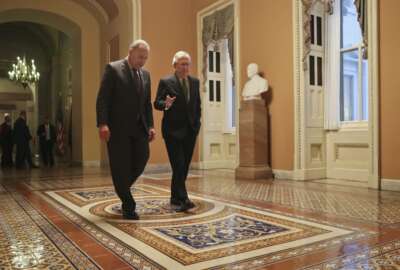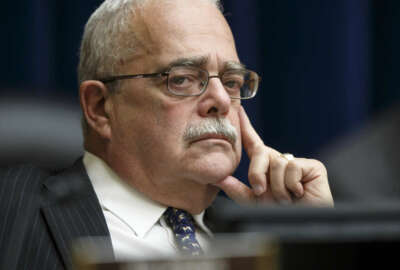
Last month’s spending cap deal brings more certainty to March 23 shutdown showdown
Lawmakers have spent the last four weeks finalizing appropriations for fiscal 2018, with the intent of packaging all 12 spending bills into one omnibus.
Lawmakers have eight legislative days to either a pass a budget or a sixth continuing resolution for fiscal 2018 before the March 23 deadline.
The deadline to avoid a third government shutdown this year is fast approaching. But unlike previous months, there’s more optimism in the air.
Congress already completed much of the more complicated work last month, when members passed the Bipartisan Budget Act of 2018. The budget act set spending caps for the next two years — at $300 billion higher than current levels — and extended current appropriations through March 23.
Lawmakers have spent the last four weeks finalizing appropriations for fiscal 2018, with the intent of packaging all 12 spending bills into one omnibus.
As long as that omnibus steers clear of any potential politically-divisive issues, Roll Call Senior Editor David Hawkings expects a relatively tame few weeks leading up to the March 23 deadline.
“The appropriators are talking about actually getting it done a few days ahead of schedule,” Hawkings told the Federal Drive with Tom Temin. “They are down to a very few issues. Negotiating these omnibuses is a little bit like a pyramid, where a vast majority of the decisions at the bottom are handled by… staffers on these various appropriations subcommittees. The ones they can’t agree on go to the members and then to the chairman and then to the leadership. Finally, the very, very pinnacle of the issues are really settled by the leadership and the White House. At this point, they’re down to just a couple of those.”
Best listening experience is on Chrome, Firefox or Safari. Subscribe to Federal Drive’s daily audio interviews on Apple Podcasts or PodcastOne.
Rep. Gerry Connolly (D-Va.) is also optimistic for the long term, if not slightly more cautious about a short term prediction.
After all, congressional leaders were confident in the days leading up to the passage of the latest CR they could avoid a second government shutdown. But last minute drama on the Senate floor forced another lapse in appropriations.
This time, the spending caps set in the Bipartisan Budget Act should bring more certainty, Connolly said.
“Having that number, and it’s at a higher level for both defense and domestic spending, gives us some breathing room and a little sense of predictability over the next year and a half,” he said Monday morning at the Federal Managers Association’s national convention in Alexandria, Virginia. “Bumping up against March 23, we may yet again not have everything worked out. … There could be a very small CR while we put the finishing touches on the omnibus, but I would expect an omnibus for the balance of the fiscal year.”
Connolly, meanwhile, is turning his attention to the familiar platter of challenges facing the federal workforce.
For the fourth consecutive year, Connolly offered an alternative pay raise for federal employees in the form of the Federal Adjustment of Incomes Rates (FAIR) Act. This time, the legislation calls for a 3 percent pay raise for 2019.
“Sometimes the press gets a little cynical, like, ‘You know that bill’s not going to pass.’ If we did nothing, then there’s no resistance at all,” Connolly said. “There’s no pressure to raise federal pay at all. By having that as a marker, we think we’ve actually been able to influence both the Obama and Trump White Houses on the subject of federal pay. We’re going to continue to do that on your behalf.”
The president’s 2019 budget proposal includes a pay freeze for civilian employees.
Connolly said he’s working with members of Congress to better educate them about their constituencies of federal employees, and he’s reminding them that the federal workforce has already had three years of frozen pay in recent years.
“When we have the opportunity to engage with my colleagues, most would ascent to the proposition that federal employees deserve a pay raise,” Connolly told reporters Monday morning. “Ideologues don’t care. Ideologues feel, ‘good enough for them to freeze their salaries.’ For other members it’s just not an issue, because it’s just not something that’s talked about in their districts. That’s why it’s so important we raise that level of dialogue back home.”
The president’s proposed cuts to the federal retirement system also has Connolly’s attention. The recommendations to increase employee pension contributions by 1 percent a year, eliminate the cost-of-living adjustment for participants in the Federal Employee Retirement System (FERS), base future retirement benefits on the highest five years of a worker’s salary and eliminate the special retirement supplement for employees over age 62 represent a “breach in contract,” Connolly said.
They’re also an attempt to make agencies more dysfunctional and less desirable places to work, he added. But Connolly believes he can help change the dialogue.
“If informed, if educated about who… federal employee[s are] and what do they do… I think that educational process would go a long way toward maybe softening some of the rhetoric and some of the actions my colleagues have taken,” he said.
The education process is a long one, but Connolly said he’s seen his colleagues change their votes in the past.
“We have a fight on our hands,” he said. “We’re up to it. We’ve been able to roll back or beat back a lot of this, but it’s a never ending process.”
Copyright © 2025 Federal News Network. All rights reserved. This website is not intended for users located within the European Economic Area.
Nicole Ogrysko is a reporter for Federal News Network focusing on the federal workforce and federal pay and benefits.
Follow @nogryskoWFED





